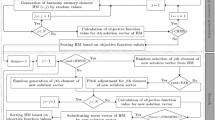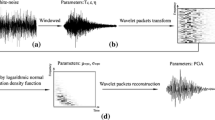Abstract
Seismic signals are non-stationary in nature, generated by earthquake and some other sources like explosive, landslides etc. In this paper, pattern of time varying frequency components of real-time recorded data of seismic signal are investigated by computing the mean of Gabor transform. In most of the cases, it is not possible to use recorded data of strong ground motion at a given site. It is therefore essential to analyze synthetic time-history which gives the prediction of strong ground motion in the regions where actual records can’t be used. In this work, the problem has been shown in synthetic time-histories where time–frequency variation is not controlled and suggested Gabor transformation based approach for generation of site specific synthetic time-history having control on time–frequency variation. Synthetic time-histories have been generated at five different sites by computing the average of Gabor transform of eight records for different earthquakes at each site. It is also shown that shape of response spectrum calculated from the generated synthetic time-history at each site is quite comparable to shape of mean response spectrum of recorded time-histories. Synthetic time-histories of a realistic time–frequency variation will be very useful for the researchers who wish to perform the nonlinear analysis of structures for a particular site.










Similar content being viewed by others
References
Boashash B (1996) Time frequency signal analysis: Past, present and future trends. Signal Processing Research Centre. Control Dyn Syst 78:1–69
Boashash B (2003) Time–frequency analysis and signal processing—a comprehensive reference. Elsevier, Oxford
Boore DM (1983) Stochastic simulation of high-frequency ground motions based on seismological models of the radiated spectra. Bull Seismol Soc Am 73(6):1865–1894
Boore DM (2003) Simulation of ground motion using the stochastic method. Pure Appl Geophys 160(2003):635–676
Botero FMU, Huerta Lopez CI, Caro-Cortes JA, Martínez-Cruzado JA, Suarez-Colche LE (2012) Joint time–frequency analysis of seismic records. 15th World Conference on Earthquake Engineering
Cano Saldana L (2008) On time–frequency analysis for structural damage detection. Ph.D Thesis, University of Puerto Rico Mayagüez Campus
Danisor A, Izet-Unsalan KO, Unsalan D (2007) A new approach for the detection and processing of seismic signals. IEEE 3rd International conference on recent advances in space technologies, pp 698–703
Ding J-J (2012) Time–frequency analysis tutorial Gabor feature and its application. Tutorial, R99942057, pp 1–25
Douglas LJ, Parks TW (1987) Time–frequency window leakage in the short time Fourier transform. Circuit Syst Signal Process 6(3):2222–2225
Ferguson BG, Quinn BG (1994) Application of the short-time Fourier transform and the Wigner–Ville distribution to the acoustic localization of aircraft. J Acoust Soc Am 96(821):821–827
Huang M, Pan BY (2011) Application of signal analysis in seismic wave processing. IEEE International Conference on e-Commerce and e-Government, pp 1–4
Jennings PC, Housner GW, Tsai NC (1968) Simulated earthqauke motions for design purposes. California Institute of Technology: Earthquake Engineering Research laboratory A-1:145–160
Joshi A, Sandeep, Kamal (2014) Modeling of strong motion generation areas of the 2011 Tohoku, Japan earthquake using modified semi-empirical technique. Nat Hazards 71:587–609
Khan NA, Noman Jafri M, Saad AQ (2011) Improved resolution short time Fourier transform. In the procedding of IEEE 7th international conference on emerging technologies, pp 1–3
Kumar A (2002) Generation of spectrum compatible time-history. Proceedings of 12th Symposium on Earthquake Engineering
Kumar A (2004) Software for generation of spectrum compatible time-history. 13th World Conference on Earthquake Engineering
Lopez CIH, Yong JS, Powers EJ, Roesset JM (2000) Time-frequency analysis of earthquake records. 12th World Conference on Earthquake Engineering, WCEE
Nuruzzaman Abul, Ozdal Boyraz, and Bahram Jalali (2006) Time-stretched short-time Fourier transform. IEEE Transactions on Instrumentation and Measurement, 55
Qian S, Dapang C (1999) Joint time-frequency analysis: IEEE Signal Processing Magazine, 16:52–57
Rezaeian S, Der Kiureghian A (2010) Simulation of synthetic ground motions for specified earthquake and site characteristics. Earthq Eng Struct Dyn 39(10):1155–1180
Rezaeian S, Luco N (2012) Example applications of a stochastic ground motion simulation methodology in structural engineering. 15th World Conference on Earthquake Engineering, WCEE
Roshan K, Sumathi P, Ashok K (2013) De-noising of seismic signals based on Gabor transform. IEEE International Conference on Advances in Computing, Communications and Informatics, 1996–2001
Roshan K, Sumathi P, Ashok K (2014) Frequency Shifting Analysis of Seismic Signals Using Gabor-Wigner transform. Earthq Eng Eng Vib (accepted)
Stankovic L (1994) A method for time-frequency analysis. IEEE Trans Signal Process 42(1):225–229
Suarez LE, Montejo LA (2005) Generation of artificial earthquakes via the wavelet transform. Int J Solids Struct 42(21):5905–5919
Todorovska M, Trifunac M (2007) Earthquake damage detection in the imperial county services building: the data and time-frequency analysis. Soil Dyn Earthq Eng 27(6):564–576
Zielinski TP (2001) Joint time-frequency resolution of signal analysis using Gabor transform. IEEE Trans Power Deliv 50(5):1436–1444
Author information
Authors and Affiliations
Corresponding author
Rights and permissions
About this article
Cite this article
kumar, R., Sumathi, P. & Kumar, A. A time–frequency approach for generation of synthetic time-histories of earthquake signals. Acta Geod Geophys 51, 57–67 (2016). https://doi.org/10.1007/s40328-015-0115-7
Received:
Accepted:
Published:
Issue Date:
DOI: https://doi.org/10.1007/s40328-015-0115-7




